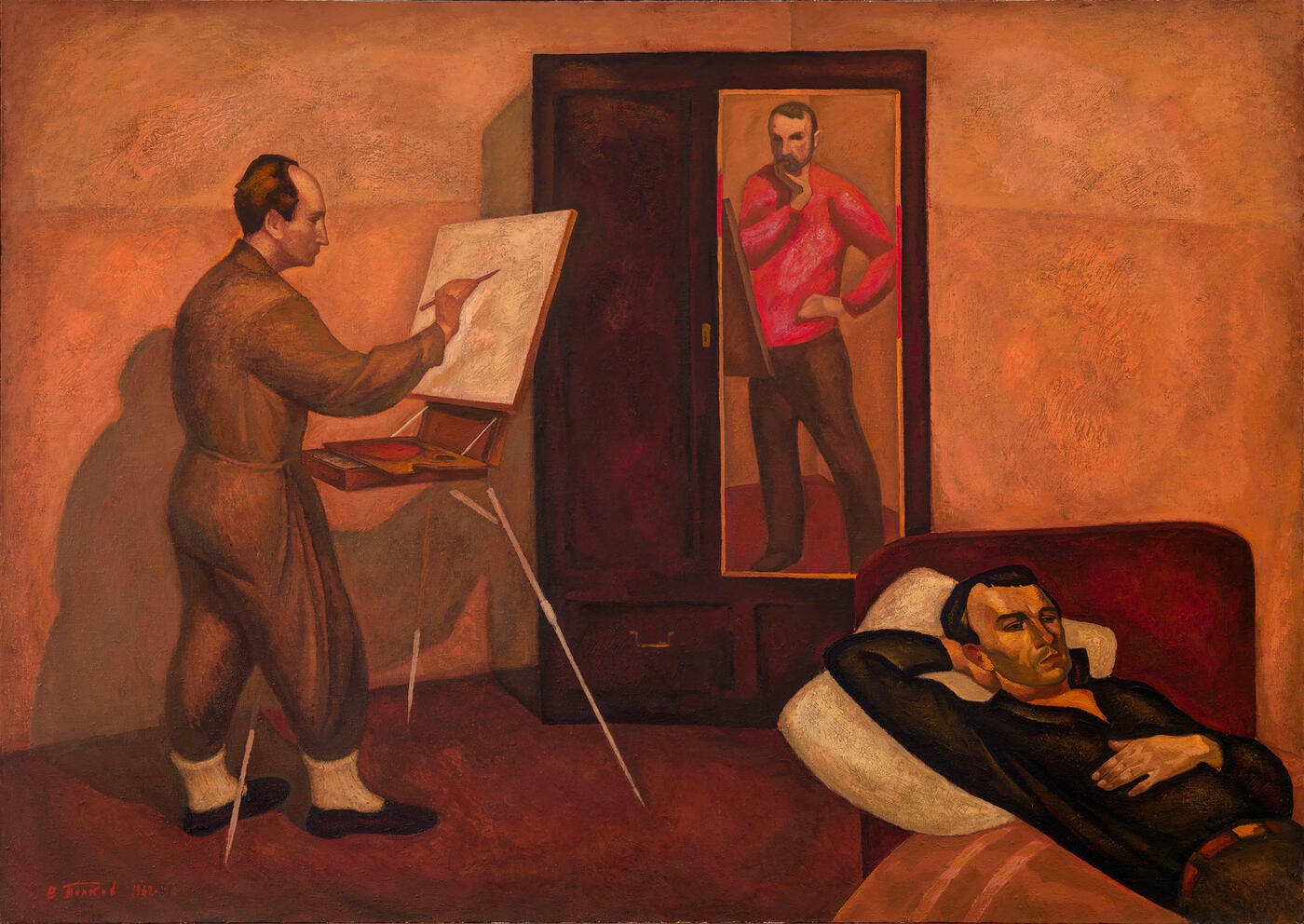8 June 2016 Russian Art and Photography Auctions
8 June 2016

* 135. POPKOV, VIKTOR (1932-1974)
Three Artists, signed and dated 1962, also further signed, titled in Cyrillic and dated on the reverse.
Oil on canvas, 160 by 225.5 cm.
80,000-120,000 GBP
Executed in 1962–1963.
Provenance: Acquired directly from the artist’s family by the present owner.
Private collection, UK.
Exhibited: Viktor Popkov (1932–1974). Genius of the Russian Soul, Somerset House, London, 22 May 2014–18 June 2014.
Literature: Viktor Popkov. A Russian Painter of Genius, London, Unicorn Press, 2013, pp. 148, 149, illustrated.
Exhibition catalogue, Viktor Popkov (1932–1974). Genius of the Russian Soul, London, Unicorn Press, 2014, No. 12, illustrated.
Without any exaggeration, one can name the work of Viktor Popkov as the driving force behind the immense breakthrough in Soviet figurative art. The artist was one of the founders of the so-called Severe style that emerged in the early 1960s during the Khrushchev thaw. Popkov’s colleagues and kindred spirits were an entire generation of outstanding artists from Moscow, amongst them notably Geli Korzhev, Nilolay Andronov, Tair Salakhov, Petr Ossovsky and Pavel Nikonov. Their principal ambition was to reveal the truth about mundane life and work of a Soviet man, bereft of any embellishments and far removed from the sterile version propagated by totalitarian academism.
There was a perfect match between these artists’ goal and their painterly style: generalised, with restrained colours and brutal plasticity. A perfect example is Popkov’s iconic Builders of the Bratsk Hydro-Electric Power Station (1961) – a painting that is not only the most important in the artist’s oeuvre but crucial to the overall development of the Severe style. By the mid-1960s, Popkov’s work as a whole was changing, with the artist shifting his emphasis from socially relevant topics to more personal, idyllic subject matter. In contrast to the official art of Stalin’s era that reflected state ideology, Popkov’s work expressed the voice of the author as an individual. Popkov’s narrative unfolds from the inside of his protagonists, speaking in the first person. The artist openly expressed his feelings for his nearest and dearest and other ordinary people, their daily life and the world around them.
Popkov paints many self-portraits and portraits of other artists, attempting to “distil” his inner world and come to understand the mission of a creative person. One day in the summer of 1962, while in Arkhangel on a trip around the north of Russia, he conceived a monumental self-portrait which would also feature his fellow artists Karl Friedman (on the left) and Aleksandr Sorochkin. The finished painting became one of his most impressive works.
Popkov re-interprets the classic “three-point” composition and dynamically modifies it within the enclosed space of a small room, visually expanded through the inclusion of a wardrobe with a built-in mirror. Reflected in the mirror is the artist himself, standing by his easel, lost in his thoughts. The reflection in the mirror considerably enhances the effect the author’s presence has in the picture, as he calmly observes the goings-on. Meanwhile, the intensity of the ochre and carmine palette is pared down by the dim electric light of the hotel room. The painting is flawless in its carefully measured precision and unhurried execution. No tiny detail is fortuitous; every aspect bears out the artist’s urge for solitude and meditative calmness.
The three men – three kindred spirits, three personalities, distinct yet close to one another – are next to each other in the physical confines of the room but simultaneously detached. Each is fully immersed in his own thoughts, and the silence that permeates the place seemingly lasts an eternity.
Notes on symbols:
* Indicates 5% Import Duty Charge applies.
Ω Indicates 20% Import Duty Charge applies.
§ Indicates Artist's Resale Right applies.
† Indicates Standard VAT scheme applies, and the rate of 20% VAT will be charged on both hammer price and premium.